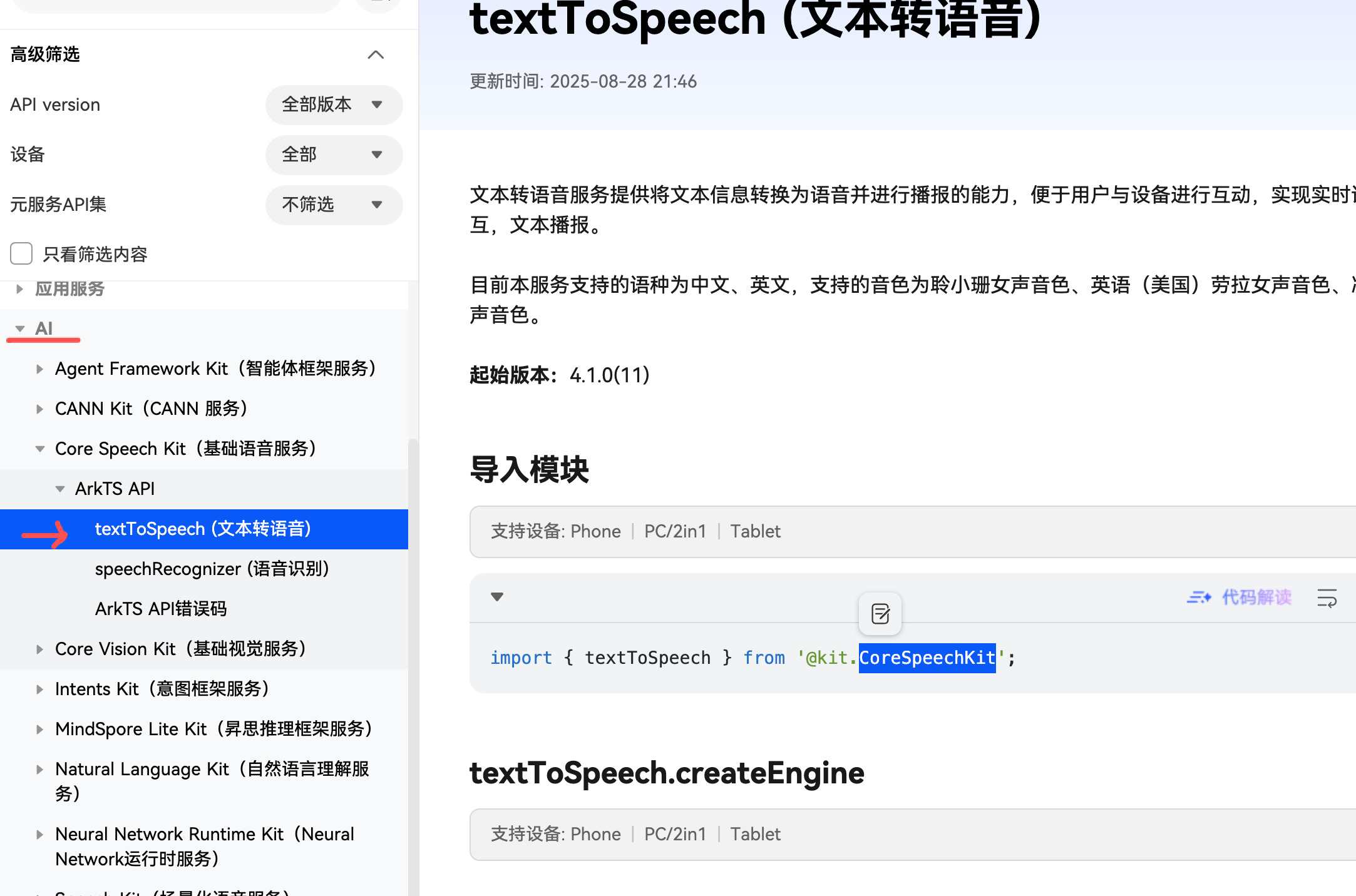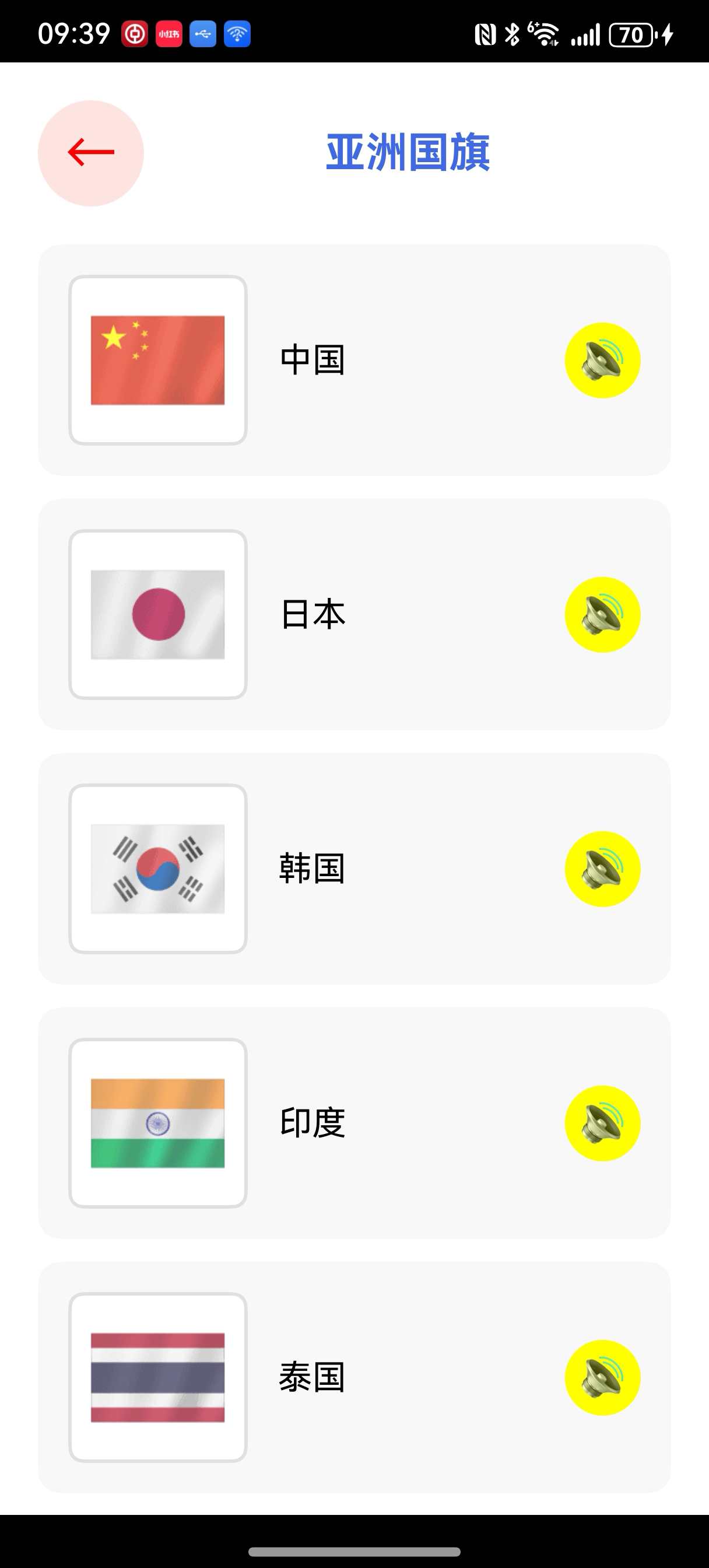开发中使用——鸿蒙CoreSpeechKit让文字发声
文章目录
- 开发中使用——鸿蒙CoreSpeechKit让文字发声
- 一、不得不说\"小艺\"
- 二、具体实现(只需三步)
- 三、如何使用
-
- 1.得到语言引擎管理实例
- 2.初始化语言引擎和配置
- 3.传入文本,生成语音
- 四、使用技巧
- 五、展示(Show your Time)
- 六、参考文档
- 七、代码奉上(仅供参考)
开发中使用——鸿蒙CoreSpeechKit让文字发声
不再是一个安安静静的“APP”,做一个可以发出声音,甚至讲话、与人进行交互,是一个APP孜孜不倦的追求和最终理想。————一个APP的独白。
一、不得不说\"小艺\"
-
渊源:华为手机自带语言助手\"小艺\",也是一个语言AI,手机系统自带,同样支持鸿蒙Next(你懂得)。
-
特点:支持将一篇不超过10000字数的中英文文本(简体中文、繁体中文、数字、英文)合成为语音,并以选定音色进行播报。
-
场景:手机/平板等设备在无网状态下,系统应用无障碍(屏幕朗读)接入文本转语音能力,为视障人士或不方便阅读场景提供播报能力(无网络也用,就说牛不牛)。
-
语言:支持的语种为中文、英文
-
音色:支持的音色为聆小珊女声音色、英语(美国)劳拉女声音色、凌飞哲男声音色。
-
AI: 实打实的AI,这是基于手机系统提供的CoreSpeechKit基础语言服务,属于AI模块。
有下图为证。

二、具体实现(只需三步)
- 实现原理,要初始化文本转语言的引擎(TextToSpeechEngine),然后给它配置参数、配置回调;然后就可以使用它进行操作了,让它干活了。
1.创建文本转语言引擎(TextToSpeechEngine)
调用createEngine接口,创建TextToSpeechEngine实例。并初始化引擎。使用callback异步回调。
createEngine(){ // 设置创建引擎参数 let extraParam: Record = {\"style\": \'interaction-broadcast\', \"locate\": \'CN\', \"name\": \'EngineName\'}; let initParamsInfo: textToSpeech.CreateEngineParams = { language: \'zh-CN\', person: 0, online: 1, extraParams: extraParam }; // 调用createEngine方法 textToSpeech.createEngine(initParamsInfo, (err: BusinessError, textToSpeechEngine: textToSpeech.TextToSpeechEngine) => { if (!err) { console.info(\'Succeeded in creating engine\'); // 接收创建引擎的实例 this.ttsEngine = textToSpeechEngine; } else { console.error(`Failed to create engine. Code: ${err.code}, message: ${err.message}.`); } }); }2.创建引擎需要的参数(SpeakParams、SpeakListener)
得到TextToSpeechEngine实例对象后,实例化SpeakParams对象、SpeakListener对象,并传入待合成及播报的文本originalText,调用speak接口进行播报。
initParam(){ // 设置speak的回调信息 this.speakListener = { // 开始播报回调 onStart(requestId: string, response: textToSpeech.StartResponse) { console.info(`onStart, requestId: ${requestId} response: ${JSON.stringify(response)}`); }, // 合成完成及播报完成回调 onComplete(requestId: string, response: textToSpeech.CompleteResponse) { console.info(`onComplete, requestId: ${requestId} response: ${JSON.stringify(response)}`); }, // 停止播报回调 onStop(requestId: string, response: textToSpeech.StopResponse) { console.info(`onStop, requestId: ${requestId} response: ${JSON.stringify(response)}`); }, // 返回音频流 onData(requestId: string, audio: ArrayBuffer, response: textToSpeech.SynthesisResponse) { console.info(`onData, requestId: ${requestId} sequence: ${JSON.stringify(response)} audio: ${JSON.stringify(audio)}`); }, // 错误回调 onError(requestId: string, errorCode: number, errorMessage: string) { console.error(`onError, requestId: ${requestId} errorCode: ${errorCode} errorMessage: ${errorMessage}`); } }; // 设置回调 this.ttsEngine?.setListener(this.speakListener); }3.调用播报方法
让它干活,调用播报方法,开发者可以通过修改speakParams主动设置播报策略
speak(text:string){ // 设置播报相关参数 this.extraParam= {\"queueMode\": 0, \"speed\": 1, \"volume\": 0.1, \"pitch\": 1, \"languageContext\": \'zh-CN\', \"audioType\": \"pcm\", \"soundChannel\": 3, \"playType\": 1 }; this.speakParams = { requestId: new Date().getTime().toString(), extraParams: this.extraParam }; // 调用播报方法 // 开发者可以通过修改speakParams主动设置播报策略 this.ttsEngine?.speak(text, this.speakParams); }4.停止播报
让它闭嘴,当需要停止合成及播报时,可调用stop接口。
stop(){ // 当需要查询文本转语音服务是否处于忙碌状态时 // 才停止播报 if(this.ttsEngine?.isBusy()){ this.ttsEngine?.stop(); } }三、如何使用
1.得到语言引擎管理实例
我是将上述的方法,整理出了一个单例类TextToSpeechManager,方便在APP中全局使用。
private textToSpeechManger = TextToSpeechManager.getInstance();2.初始化语言引擎和配置
在将要进入页面时,在方法aboutToAppear()中进行初始化。
aboutToAppear() { /// 初始化文本转语言引擎 this.textToSpeechManger.createEngine(); this.textToSpeechManger.initParam();}3.传入文本,生成语音
this.textToSpeechManger.speak(\'Hello kit\');四、使用技巧
我是用到了就写一下,后面用到了再进行补充。
- 设置停顿,[p500],表示停顿500ms
this.textToSpeechManger.speak(\'Hello[p500] kit\');五、展示(Show your Time)
我不知道怎么上传视频,还是算了吧。就上传一张图片吧。

六、参考文档
官方文档
七、代码奉上(仅供参考)
import { textToSpeech } from \'@kit.CoreSpeechKit\';import { BusinessError } from \'@kit.BasicServicesKit\';/** * 文本转语音 * 使用:Core Speech Kit * 支持将一篇不超过10000字数的中英文文本(简体中文、繁体中文、数字、英文)合成为语音,并以选定音色进行播报。 * 场景支持 * 手机/平板等设备在无网状态下,系统应用无障碍(屏幕朗读)接入文本转语音能力,为视障人士或不方便阅读场景提供播报能力。 */export class TextToSpeechManager{ private static instance: TextToSpeechManager; private constructor() {} public static getInstance(): TextToSpeechManager { if (!TextToSpeechManager.instance) { TextToSpeechManager.instance = new TextToSpeechManager(); } return TextToSpeechManager.instance; } // 创建TextToSpeechEngine实例 private ttsEngine: textToSpeech.TextToSpeechEngine|null = null; // 设置播报相关参数 private extraParam: Record|null = null; // 实例化SpeakParams对象 private speakParams: textToSpeech.SpeakParams|null = null; // SpeakListener对象,设置speak的回调信息 private speakListener: textToSpeech.SpeakListener|null = null; /** * 调用createEngine接口,创建TextToSpeechEngine实例。 * createEngine接口提供了两种调用形式,当前以其中一种作为示例,其他方式可参考API参考。 * 其他创建方式:https://developer.huawei.com/consumer/cn/doc/harmonyos-references/hms-ai-texttospeech */ createEngine(){ // 设置创建引擎参数 let extraParam: Record = {\"style\": \'interaction-broadcast\', \"locate\": \'CN\', \"name\": \'EngineName\'}; let initParamsInfo: textToSpeech.CreateEngineParams = { language: \'zh-CN\', person: 0, online: 1, extraParams: extraParam }; // 调用createEngine方法 textToSpeech.createEngine(initParamsInfo, (err: BusinessError, textToSpeechEngine: textToSpeech.TextToSpeechEngine) => { if (!err) { console.info(\'Succeeded in creating engine\'); // 接收创建引擎的实例 this.ttsEngine = textToSpeechEngine; } else { console.error(`Failed to create engine. Code: ${err.code}, message: ${err.message}.`); } }); } /** * 得到TextToSpeechEngine实例对象后,实例化SpeakParams对象、SpeakListener对象,并传入待合成及播报的文本originalText,调用speak接口进行播报。 */ initParam(){ // 设置speak的回调信息 this.speakListener = { // 开始播报回调 onStart(requestId: string, response: textToSpeech.StartResponse) { console.info(`onStart, requestId: ${requestId} response: ${JSON.stringify(response)}`); }, // 合成完成及播报完成回调 onComplete(requestId: string, response: textToSpeech.CompleteResponse) { console.info(`onComplete, requestId: ${requestId} response: ${JSON.stringify(response)}`); }, // 停止播报回调 onStop(requestId: string, response: textToSpeech.StopResponse) { console.info(`onStop, requestId: ${requestId} response: ${JSON.stringify(response)}`); }, // 返回音频流 onData(requestId: string, audio: ArrayBuffer, response: textToSpeech.SynthesisResponse) { console.info(`onData, requestId: ${requestId} sequence: ${JSON.stringify(response)} audio: ${JSON.stringify(audio)}`); }, // 错误回调 onError(requestId: string, errorCode: number, errorMessage: string) { console.error(`onError, requestId: ${requestId} errorCode: ${errorCode} errorMessage: ${errorMessage}`); } }; // 设置回调 this.ttsEngine?.setListener(this.speakListener); } /** * 调用播报方法 * 开发者可以通过修改speakParams主动设置播报策略 */ speak(text:string){ // 设置播报相关参数 this.extraParam= {\"queueMode\": 0, \"speed\": 1, \"volume\": 0.1, \"pitch\": 1, \"languageContext\": \'zh-CN\', \"audioType\": \"pcm\", \"soundChannel\": 3, \"playType\": 1 }; this.speakParams = { requestId: new Date().getTime().toString(), //\'123456\', // requestId在同一实例内仅能用一次,请勿重复设置 extraParams: this.extraParam }; // 调用播报方法 // 开发者可以通过修改speakParams主动设置播报策略 this.ttsEngine?.speak(text, this.speakParams); } /** * 停止调用播报方法 * 当需要停止合成及播报时,可调用stop接口。 */ stop(){ // 当需要查询文本转语音服务是否处于忙碌状态时 // 才停止播报 if(this.ttsEngine?.isBusy()){ this.ttsEngine?.stop(); } }}/// 使用实例:// 1.初始化语言引擎和配置// private textToSpeechManger = TextToSpeechManager.getInstance();//// aboutToAppear() {// /// 初始化文本转语言引擎// this.textToSpeechManger.createEngine();// this.textToSpeechManger.initParam();// }// 2.传入文本,生成语音// this.textToSpeechManger.speak(\'Hello kit\');// 3.设置停顿 [p500],500ms// this.textToSpeechManger.speak(\'Hello[p500] kit\');

